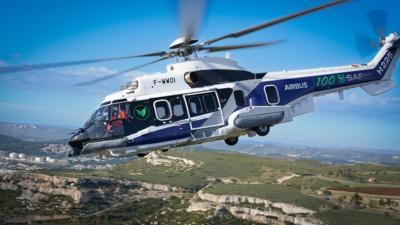Thu, Nov 11, 2021
Continuing Sustainable Fuel Work at Marignane Shows Progress
Airbus completed the first ever helicopter flight using 100% sustainable aviation fuel as part of its SAF development. As the aviation industry around the world looks to upcoming emissions, sustainability, and environmental targets, manufacturers are preparing for alternative fuels to take the stage from traditional petrochemical fuels. Airbus has launched a user group dedicated to the evaluation and integration of SAF into the rotary-wing community.

It has been a banner year for sustainable fuel, with rotorcraft competitor Bell Canada announcing the use of blended SAF in its training, transit, and customer delivery operations, with efforts to move to 100% SAF in the near future. Changing fuels is never an entirely simple process in aircraft, as safety and reliability are paramount, but stakeholders are confident it is the way forward for the industry. Airbus specifically publicized their use of the unadulterated fuel, no small feat when the currently approved SAF blend is capped at 50%.
The flight campaign successfully flew with an unblended SAF, provided by TotalEnergies, derived from used cooking oil. The H225 test helicopter apparently functioned well, and boasted a 90% CO2 reduction compared to regular jet fuel. Continued use and testing will prove what effects a longer-term flight regime has on the aircraft, but Airbus chief technical officer Stefan Thome, sounds optimistic.
“While all Airbus helicopters are certified to fly with up to a 50% blend of SAF mixed with kerosene, it is our Company’s ambition to have its helicopters certified to fly with 100% SAF within the decade. Today’s flight is an important first step towards this goal”, said Thome.
“SAF is an important pillar of Airbus Helicopters’ decarbonisation strategy because it provides immediate CO2 reduction with no negative impact on the performance of the helicopter,” he added. “I thank our partners Safran Helicopter Engines and TotalEnergies for their important collaboration in making today’s flight a reality. Further cooperation among all industry stakeholders is essential to overcome the challenges associated with implementing SAF widely and to make real progress in reducing the aviation industry’s CO2 emissions”.
More News
“Understanding how the ionosphere varies will be a really important part of understanding how to correct the distortions in radio signals that we will need to communicate wit>[...]
From 2023 (YouTube Edition): At the Confluence of Art & Information Developed by pilot, aircraft-owner, and entrepreneur Richard Freilich, METARmaps are syncretisms of visual a>[...]
Aero Linx: European Association for Aviation Psychology (EAAP) Since 1956 the European Association for Aviation Psychology (EAAP) provides a forum for professionals working in the >[...]
Also: Drone Rulemaking Stalled, LA County FD Adds FIREHAWKs, Wilsbach Confirmed, CAF Honors Vet Even with parts of the federal government on pause, Yosemite National Park isn&rsquo>[...]
Aero Linx: Ercoupe Owners Club We fly an airplane that was the peak of pre-World War II development. It took more than a decade and a half before the features of the Ercoupe were t>[...]
 Aero-News: Quote of the Day (11.08.25)
Aero-News: Quote of the Day (11.08.25) Classic Aero-TV: The Enduring Appeal of METARmaps
Classic Aero-TV: The Enduring Appeal of METARmaps ANN's Daily Aero-Linx (11.08.25)
ANN's Daily Aero-Linx (11.08.25) Airborne 11.03.25: BASE Jumpers Arrested, MOSAIC Town Hall, Beech M-346N
Airborne 11.03.25: BASE Jumpers Arrested, MOSAIC Town Hall, Beech M-346N ANN's Daily Aero-Linx (11.09.25)
ANN's Daily Aero-Linx (11.09.25)



